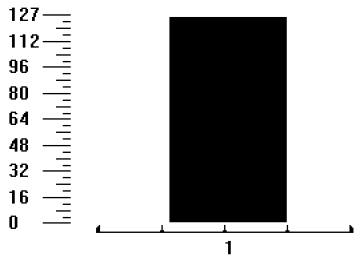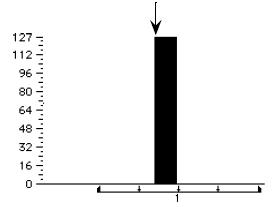If you don’t need pedal markings to appear in your score, but want to add the use of the sustain pedal to the playback of your score, you may find the following method faster than the Expression method.
Human Playback must be set to None to hear sustain indications added with the MIDI tool. See Playback Settings dialog box for Details.
- Click the MIDI tool
 . The MIDI tool menu appears.
. The MIDI tool menu appears.
- Double-click the measure in which you want the pedal to be “pressed.” The MIDI tool split-window opens.
- Choose MIDI tool > Edit Continuous Data. The View Continuous Data dialog box appears, in which you can select a controller whose data you want to edit.
- Click OK (since Sustain Pedal is already selected). You return to the MIDI tool split-window, where the display has changed. On the left side you see a scale of controller values—in this case, sustain pedal values—from 0 (pedal up) to 127 (pedal down). The sustain pedal is not a continuous controller, because its value can’t change smoothly over time (like pitch wheel data can). You’ve either pressed the pedal (value 127) or released it (value 0). Unless you’ve already created pedaling using the MIDI tool, the window is empty.
Pedaling appears in this window in bar graph form. In the example below, the pedal was depressed just after the second beat of measure 1, and released just after the fourth beat:

Controller information is independent of the actual notes being played—you can press the pedal even during a measure of rests, if you want. Therefore, you specify where you want to insert a “pedal down” message (or another noncontinuous controller, or a patch change) by dragging through a sliver of the graph area.
- Drag through a small horizontal “slice” at the beginning of the graph area, as shown. Keep in mind that the actual pedal usage will occur at the beginning of the region you select (indicated by the arrow in the figure below). It really doesn’t matter, therefore, how much of the window you highlight; the pedaling message will be inserted at the far left edge of your highlighted region.

- Choose MIDI tool > Set To. The Set To dialog box appears. Remember that to create the “pedal down” message, you need to set the pedal’s MIDI value to 127.
- Type 127. Click OK. You return to the MIDI window. Suddenly the entire graph area is black. That’s because you’ve just inserted a “pedal down” message without any corresponding “pedal up” message. Therefore, your synthesizer will think that the pedal is being pressed during the entire piece.
- Drag through a small region of the graph area at the point where you want the pedal released. If the pedal release point isn’t in the same measure, click the right arrow button to scroll the music display. Remember that the “pedal up” message will fall at the beginning of your selected region.
- Choose MIDI tool > Set To. Click OK. You don’t have to enter a number, because the default value is already zero. When you return to the window, click anywhere except in the graph area to remove the selection highlighting.
-
Click the MIDI tool to close the MIDI tool split-window. Once you’ve created one complete usage of the pedal, as you’ve just done, you don’t have to create it again in other measures that should contain a similar pedaling pattern. You can simply copy the pedaling from measure 1 into other measures. See To copy or erase captured (or edited) MIDI data.


